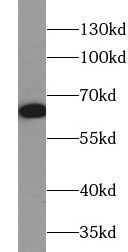Products
Pan-AKT antibody
Category:
- SPECIFICATIONS
- Product Name
- Pan-AKT antibody
- Catalogue No.
- FNab10483
- Size
- 100μg
- Form
- liquid
- Purification
- Immunogen affinity purified
- Purity
- ≥95% as determined by SDS-PAGE
- Clonality
- polyclonal
- Isotype
- IgG
- Storage
- PBS with 0.02% sodium azide and 50% glycerol pH 7.3, -20℃ for 12 months(Avoid repeated freeze / thaw cycles.)
Immunogen
- Immunogen
- human AKT1/AKT2/AKT3
- Alternative Names
- AKT1/AKT2/AKT3 antibody
- UniProt ID
- P31749/P31751/Q9Y243
- Observed MW
- 60 kDa
Application
- Tested Applications
- ELISA, WB, IHC, IF, IP
- Recommended dilution
- WB: 1:200-1:800; IHC: 1:20-1:100; IF: 1:20-1:100; IP: 1:20-1:100
Validated Images
 A549 cells were subjected to SDS PAGE followed by western blot with FNab10483( Pan-AKT Antibody) at dilution of 1:500
A549 cells were subjected to SDS PAGE followed by western blot with FNab10483( Pan-AKT Antibody) at dilution of 1:500
 Immunohistochemistry of paraffin-embedded rat kidney tissue slide using FNab10483( Pan-AKT Antibody) at dilution of 1:50
Immunohistochemistry of paraffin-embedded rat kidney tissue slide using FNab10483( Pan-AKT Antibody) at dilution of 1:50
 Immunofluorescent analysis of U2OS cells using FNab10483( Pan-AKT Antibody) at dilution of 1:50.
Immunofluorescent analysis of U2OS cells using FNab10483( Pan-AKT Antibody) at dilution of 1:50.
- Background
- Human AKT serine-threonine protein kinase family includes three members AKT1,AKT2, AKT3, which are also often referred to as protein kinase B alpha, beta, and gamma. These highly similar AKT proteins all have an N-terminal pleckstrin homology domain, a serine/threonine-specific kinase domain and a C-terminal regulatory domain. These proteins are phosphorylated by phosphoinositide 3-kinase (PI3K). AKT/PI3K forms a key component of many signalling pathways that involve the binding of membrane-bound ligands such as receptor tyrosine kinases, G-protein coupled receptors, and integrin-linked kinase. These AKT proteins therefore regulate a wide variety of cellular functions including cell proliferation, survival, metabolism, and angiogenesis in both normal and malignant cells. AKT proteins are recruited to the cell membrane by phosphatidylinositol 3,4,5-trisphosphate (PIP3) after phosphorylation of phosphatidylinositol 4,5-bisphosphate (PIP2) by PI3K. Subsequent phosphorylation of both threonine residue 308 and serine residue 473 is required for full activation of the AKT1 protein encoded by this gene.



